#8th edition 40k
Explore tagged Tumblr posts
Text
"The Iron Hands otherwise make efforts to ensure they appear to follow the Codex closely, aware of the danger should intolerant eyes dwell upon them too long. For this reason, the Chapter’s clan companies form into the squad types and numbers mandated by the Codex. Indeed, since Guilliman’s return, the Iron Council have presented the Lord Commander with myriad technical revisions to the Codex’s decrees, though what might come of this – if anything – is the business of seers and prognosticators, not beings grounded in rational wisdom."
#omg they might have waited ten thousand years but they WILL talk to the manager#wh40k#warhammer 40k#warhammer 40000#iron hands codex supplement 8th edition
23 notes
·
View notes
Text

Codex: Chaos Daemons (8th Ed) - Spoilpox Scrivener by Antonio J. Manzanedo
#Warhammer#40k#Chaos#Chaos Daemons#Spoilpox Scrivener#8th Edition#Sci-Fi#Antonio J Manzanedo#Games Workshop
46 notes
·
View notes
Text
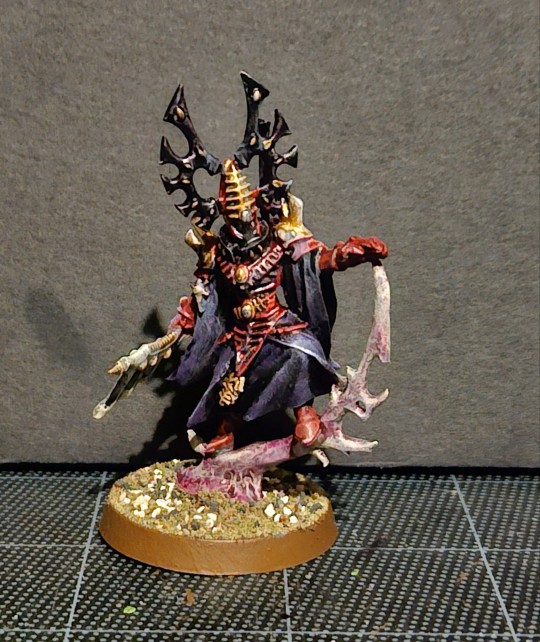

Eldar "Bonesinger", I think this is from 8th edition 40K. I found him still in the package when I was digging through my parts bin looking for pieces to complete the Wraithlords that I had inherited. Now the Wraithlords have a psychic mechanic to help repair them on the battlefield.
20 notes
·
View notes
Text
Why The Tau Were Never 'Too Good' For 40k

The Tau were added midway through Warhammer 40,000's 3rd edition, though according to some records the idea had been floating around since Laserburn. In the twenty years since their introduction to the 41st millennium, the Tau have remained one of the most consistently reviled and hated aspect of 40k lore, with all complaints around them boiling down to one core issue: they're too good for 40k. By that, people mean that they are too morally good to fit within the grimdark narrative of the 41st millennium. This has always been the primary complaint levied at them, since they were first introduced in 2001. And GW has seemingly agreed with them, and spent the last 20 years trying to inject grimdarkness into the Tau Empire.
The first attempt to grimdarkify the Tau came very early on, with the Tau campaign in Dawn of War: Dark Crusade
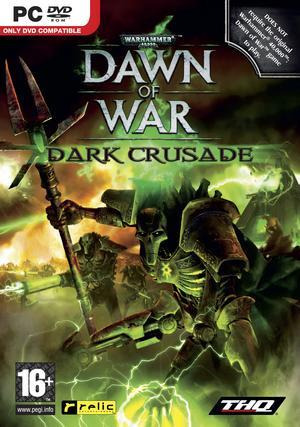
It's explained how in the decade following Tau victory on Kronus the remaining human population was subjugated, oppressed, forced to give up their culture, and eventually simply sterilized and allowed to die off naturally to create a Tau and Kroot ethnostate on Kronus. It explains this over images of prisoners of war being fed to Krootox in prison camps and humans huddling together in slums.
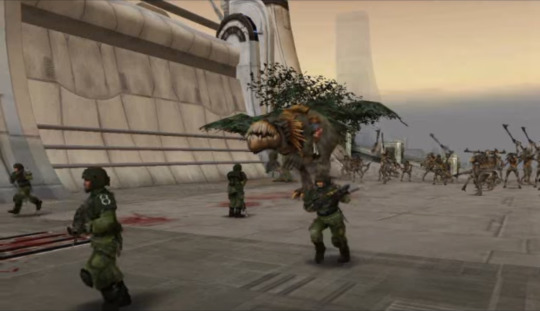

This is obviously a departure from the image of the Tau as it was established in Codex: Tau (3rd Edition), as that codex makes explicit mention of the Tau trading and making alliances with frontier human colonies. This is also a departure from... common sense. Why exactly would the Tau accept Kroot, Vespid, Nicassar, Demiurg, Tarellians and many others into their ranks but then arbitrarily draw the line at humans?
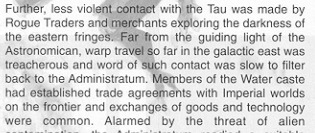
This would become a pattern that I like to call "The Grimderp Tau Cycle." It's not exactly a stretch to say that the Tau are easily the most morally good society in the 41st millennium. Their tolerance toward other species alone makes them head and shoulders above almost any other species in the galaxy. So to remind people that there are no good guys in the 41st millennium and that this is a very serious and grimdark setting that you need to take seriously because there are no good guys or whatever, GW will occasionally have the Tau commit a completely out of character, random, and nonsensical atrocity. This was also seen at the end of In Harmony Restored, the short story that came out alongside 8th edition's Psychic Awakening: The Greater Good.
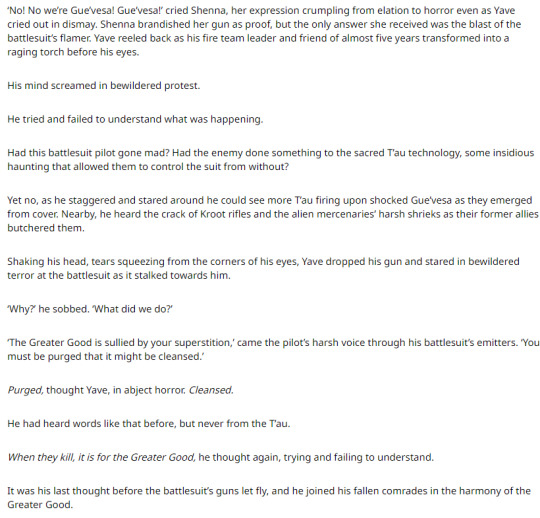
For context, In Harmony Restored is a short story about a group of Gue'vesa soldiers (human auxiliary troops fighting in the Tau military) performing a desperate defensive rearguard action to halt an Imperial advance long enough for Tau reinforcements to come and smash the delayed invasion force. The Gue'vesa are able to do this, though at great sacrifice to themselves, and then when the reinforcing army does arrive and makes quick work of the Imperial army they then continue on to butcher the Gue'vesa soldiers who performed this valiant holding action for... Seemingly no reason? Assuming the Tau forces thought they were more Astra Militarum soldiers, the Gue'vesa step out of cover pleading for mercy, only to be gunned down. With one of the Gue'vesa at the end noting that the language one of the Battlesuit pilots is using is very reminiscent of the way the Imperium talks about those they've labeled undesirables.
The message here is clear: these humans betrayed the Imperium in order to escape from the Imperium's genocidal regime... Only to end up in the equally merciless clutches of an equally ruthless oppressor. But, from a lore standpoint, that defeats the entire purpose of the Tau. It makes them wholly indistinct and, frankly, boring. But that doesn't even scratch the surface of how stupid this is, because it has clearly been stated in the past that the Tau do not hold bigotries toward client species on the basis of their faiths. And that makes sense.
Not only does this contradict previous lore, not only does it render the Tau a boring palette swapped version of the Imperium, it also just defies practical sense. If you're a race like the Tau, who expand primarily through ingratiating yourself with other races and convincing them to join your collective, you'd naturally want as few barriers between potential client races and joining as possible. No human colony is going to voluntarily join the Greater Good if the Tau's version of the Greater Good happens to require that the human population of that planet lose all sense of their heritage and culture through forced reeducation and the abandonment of their faith, and in the long term for that human population to slowly go extinct through gradual forced sterilization and confinement to ghettos and slums.
It's deeply stupid, lazy writing on the part of GW to repair the image of the Tau in the eyes of a fandom who accused the faction of being "too good." Except, uhm, here's the thing: the Tau were never too good to begin with. Lets rewind back to 3rd Edition's Tau Codex, our first introduction to the Tau in the 40k universe. From the very beginning it was very clear that the Utopian idealism of the Tau Empire held beneath the surface a significantly more sinister and malevolent nature, and it all roots from the mysterious and enigmatic fifth caste of Tau Society: the Ethereals.

In 3rd Edition, the Ethereals are spoken of more like mythological beings than the slightly mundane way they exist in modern 40k. All we know about them out of this book is that they are the autocratic leaders of the Tau Empire who inspire radical devotion among the Tau, though are rarely seen or heard from. They reorganized Tau society with pursuit of the Greater Good in mind first. But the specifics of what that means matters a lot. Tau are born into a caste that roughly determines, from birth, what role in society that person will fulfill. Those born into a caste are not allowed to have children with members of other castes, are not allowed to take up any job or position that contradicts the societal purpose of their caste, and generally lack self-determination in regards to things like career choice.
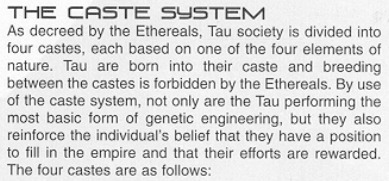
so, bam, the setup for Tau as a flawed and morally ambiguous faction are already present. They're a faction who fight for a better future, for a galaxy where all can exist in harmony with one another, so long as that harmony is kosher by the standards of the Ethereal caste. In that sense they're somewhat similar to the Dominion from Star Trek: Deep Space Nine. A multispecies interstellar collective who seek to create a galaxy harmoniously unified... in service to the Founders. Just taken from this vision of the Tau Empire, they're already an autocratic dictatorship who fight in the name of an ideology that declares itself to be for the greater good of all who ascribe to it while also relying on the assumption that the tyrannical power of the Ethereals must inherently be for the Greater Good. I reject the idea that the Tau were ever "too good" for 40k. Rather that they were written with a realistic level of nuance, with an understanding that dictatorships are built upon cognitive dissonance, not on perfectly consistent virtues.
TL;DR THEY'RE NOT FUCKING COMMUNISTS, THEY LITERALLY HAVE A CASTE SYSTEM, WHAT THE FUCK ARE YOU TALKING ABOUT?!
#warhammer40k#warhammer#warhammer 40k#t'au empire#t'au#fire warrior#in this essay i will#wargaming#warhammer lore
417 notes
·
View notes
Text
Here's something for you guys to latch onto. It's something I'm quite excited about!
I know a lot of you don't play 40K, but something rather interesting could be happening during summer this year. Back in 2023, Games Workshop released the 10th edition of Warhammer 40K. I know, I know, but don't get switched off just yet. Things are going to get very fun.
You may know through cultural osmosis that there are four Chaos gods. Tzeentch, Khorne, Nurgle and Slaanesh.
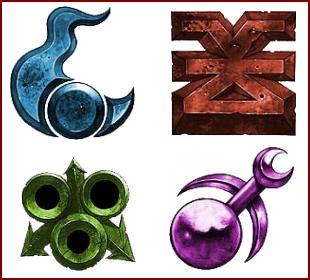
Well for many years they all shared one rulebook, but back in 8th edition, two of them (Nurgle and Tzeentch) spun off into their own armies. This was followed last year by Khorne who got theirs right at the end of 9th edition.
But in addition to new rulebooks, they also got their army leader, known as a Primarch, to take them into battle.


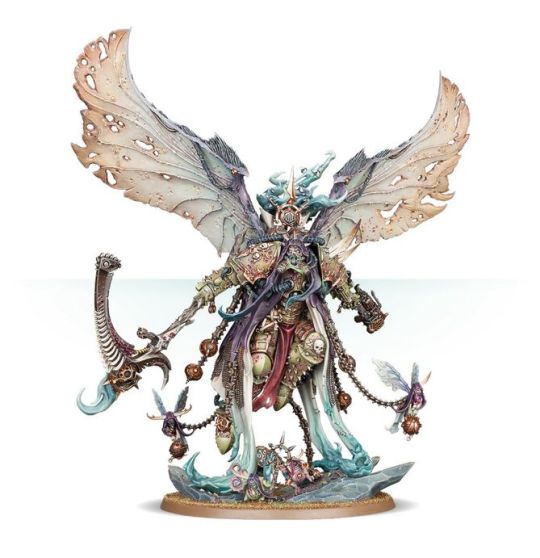
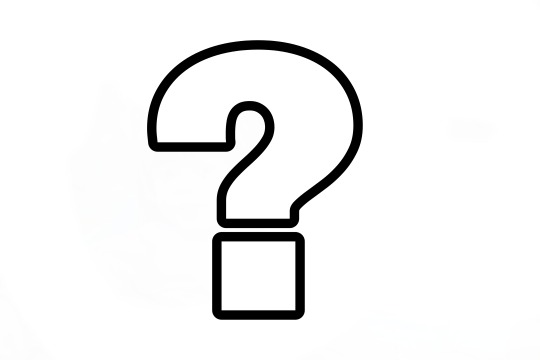
Now what's interesting here is that they all have benefitted from gifts of their respective gods. Magnus has a staff and enhanced psychic powers, Angron has two powerful close combat weapons (to create blood for the blood god), while Mortarion has the enduring strength of rot and decay. In additon, they all underwent changes to reflect their respective gods. All very fluffy and tied heavily to the lore. These are really fun models and their rules are fucking cool!
But we're missing Fulgrim, the Primarch seduced by Slaanesh. And THIS is where it gets interesting. Slaanesh is the god of excess. They revel in striding over boundaries and feel most comfortable being who they are. Followers of Slaanesh often gain powers and benefits tied to their perversions, sexual or otherwise. And it is highly believed that Fulgrim is next in line to get a model.
Looking at GW's roadmap, you can see that there's a spot for a whole new army coming out (listed as [redacted]):
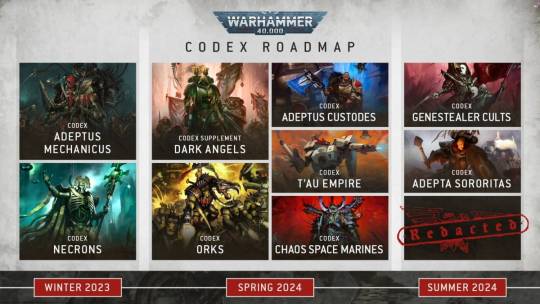
There is HUGE speculation that this is the fourth and final Chaos god codex (the name for the rulebooks). This means that we will get a new Fulgrim model, and we're itching to see what 10,000 years of daemonic servitude has blessed him with.
And I say "new" model, because we have one of him back when he first turned. This is part of their "Horus Heresy" range, and not Warhammer 40K proper. The other three Primarchs also have HH models too, different from the ones above.

Sexy, right?
But here's the thing. One of Slaanesh's defining traits is that they play with and change gender frequently. Actually, it would be just as appropriate to say that gender doesn't really apply to them unless they want it to. For example, here is a huge daemon from the range:
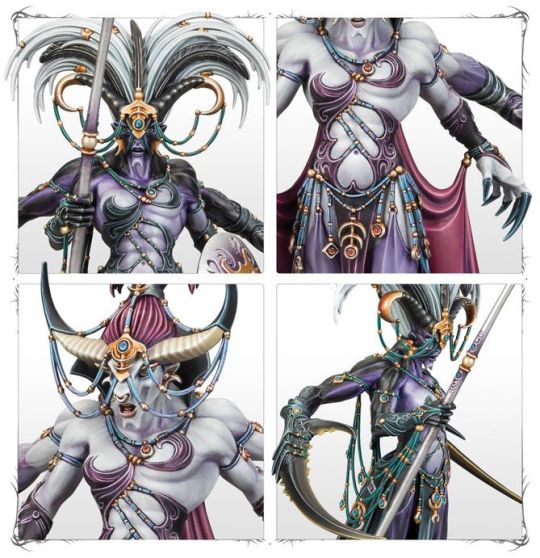
As you can see, there's a lot of androgeny here. That's intentional. Sometimes they appear more traditionally feminine, sometimes more masculine, sometimes both, sometimes neither.
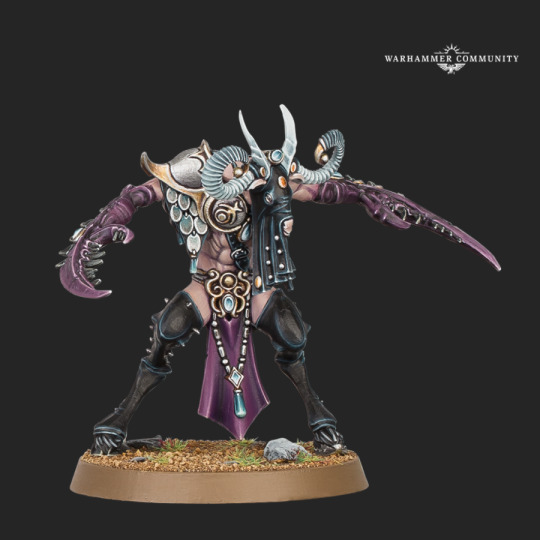
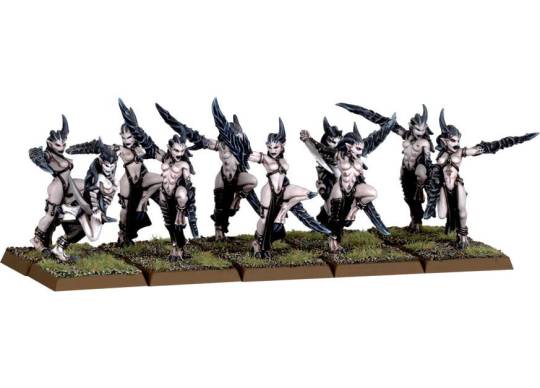
And their forms shift to seduce the prey. It's brilliant!
But this leaves the question - what about Fulgrim?
I suspect that GW could do something incredible. I think they're going to heavily lean into the best parts of Slaanesh. I think that they're going to reveal a female, or genderfluid Fulgrim!
It would make so much sense. It's the best fit for the lore. It would be so weird to just have a random bloke standing there when everybody else is already living it up as their best and most open selves, you know? It would make her distinct from her brothers, we would get a phenomenally cool Daemon Princess model, and it would definitively shut up all of those guys who get funny about the idea of female space marines, because we'd finally have one in canon!
I mean, even the existing model is called Fulgrim "trans"-figured! Could it be any more obvious?
Trans Fulgrim please, GW.
#Warhammer#Warhammer 40K#40K#WH 40K#WH40K#Fulgrim#Slaanesh#Emperor's Children#Trans#Transgender#Trans Fulgrim#Demon#Daemon#Daemonettes#Khorne#Nurgle#Tzeentch#Chaos#Chaos Space Marines#World Eaters#Death Guard#Thousand Sons#Space Marines
75 notes
·
View notes
Note
Hi! Love your blog! Warhammer is something I've been interested in for a long time. I loved playing the Dawn of War trilogy when I was younger. But the lore and world and sheer amount of games involving W40K is a bit overwhelming. I was wondering if you had some insight on where to "start", especially in terms of learning world lore. Sure I could watch 175 hours of YouTube videos but.....I'd rather not.
Hi, happy to lend a hand!
40k has two main ways of learning lore, the rule books/codices, and novels published by Black Library. The latest edition of core rules (10th edition) released last july and about 50% of that massive tome is background on the setting and various factions competing on the galactic scale. Smaller more faction specific codices have been released this edition for Tyranids, Necrons, Space Marines, Dark Angels, Mechanicus and the Necrons.
Old editions and codices can be bought on ebay or other resellers for pretty cheap if you’re just interested in lore, though i’d personally recommend sticking to 7th edition at the earliest as several now-prominent factions had not been developed before then (Mechanicus, Custodes, Chaos Knights, Leagues of Votann for example all got their first codices in 8th or 9th edition).
Novels set in the 40k universe are available from Black Library publishing directly, or through bookstores or possibly your local library. These are broken into ~3 categories relevant to 40k. 1) The ~50 book Horus Heresy series takes place 10K years prior to the current game setting and explains the speedrun rise and fall of the human Imperium. 2) Dawn of Fire, an 8 book series focused on developing the current 40k setting and the Indomitus Crusade 3) Standalone 40k books which focus on certain events or characters of interest from nearly every faction. Idk what characters or races have caught your interest, but Option 3 has the most diversity, and generally does not require having read one book to understand another. There are small exceptions such as novels about Ahriman, Belisarius Cawl, or the Plague Wars, having multiple books though, so do a quick google search before you purchase. Audiobooks are also available for a significant portion of Black Library’s offerings.
For general wikipedia style link-diving i highly recommend Lexicanum.
Let me know if you have any further questions, happy to help! :D
30 notes
·
View notes
Note
What is your take on the best reading order for Salamanders-stuff?
I starteed with the first half of the Heresy, jumped to Vulkan's Primarch-novel after Unremembered Empire, read the "let's bring him back"-arc of the Heresy, Read the 40k Omnibus, returned to the Heresy ... and that was NOT ideal!
So, what would you recommend? And, what aditional 40k-books besides the Omnibus do you think are esential?
TL;DR - I'm not the best person to ask because I'm not a Horus Heresy reader, but imo, if you're not invested in the Horus Heresy, go straight to Nick Kyme's 40k stories. First read the short story The Burden of Angels. Then, pick up the new Lords of Nocturne set that includes my favourite Salamander novel, Rebirth.
Alternatively, if you don't get along with Nick Kyme's style, read Forge Master by David Annandale first and then try the Nick Kyme books. If you are invested in the Horus Heresy already, maybe starting there is better, but I'm not the best person to ask about that.
If you prefer to listen to your books, there is an audiobook for Rebirth and an audiodrama called Fireborn. There are also audiobooks for all the Horus Heresy titles.
Long answer below!
To be honest, I'm not sure I have a good answer for this because any time anyone discusses reading orders, I always think "Whatever order keeps you interested and reading is the best." 😅
Also, I know this is pretty much a crime, but I haven't finished the Salamander-focused Heresy-era books. I... Really struggle with the Heresy, tbh. I fell in love with 40k through a tabletop RPG set in the 41st millennium, and I still tend to think of the Heresy as a quasi-mythical thing that happened in the distant past. Currently, I use the Heresy-era books I have as reference material, but I recognize that not completing them leaves huge gaps in my knowledge. I plan to get through the Salamanders ones (and a few other 30k books, including Josh Reynolds’ ones!) this year.
I read the Tome of Fire series around 2019 and have gone back to various parts since, but I haven't fully reread it. I should do that. I've reread Rebirth a few times, including recently, because it hits juuust right for me. Also, I have a physical copy. 😅
I don't feel super qualified to answer because of all that, but I suppose my recommendation would depend on whether the reader jives with Nick Kyme's writing or not.
After that, a reader has three choices: Dive into the Horus Heresy, go for David Annandale’s Primarch novel and/or his Space Marine Battles Book Forge Master, or follow me into the sad world of scrounging for snippets in codexes and White Dwarf. 😭
If they already like 40k and don't mind Nick Kyme's style, they should read the short story The Burden of Angels.
Then, the available choices are either the 40k Salamanders books or the Horus Heresy. Unless a reader is already invested in the Heresy series, I'd say pick up the Lords of Nocturne collection that's currently (as of July 2024) out as an ebook and will release in print in September 2024, as that will contain the whole of his Salamanders series, several short stories and Rebirth. (Finally! Maybe people will actually read my favourite Salamanders novel now.) Alternatively, the old Salamanders Omnibus has most of the same material, but without Rebirth. But why would you miss out on the best book in the series!
That being said, I honestly think the 8th Edition Codex: Salamanders is worth a look for readers, despite being game-focused. There are lots of fiction snippets in there. Would be fun to see fanfic authors expand some of them... FFG's Deathwatch RPG sourcebook also does a good job at setting the vibe, though it's older and a little out of date. Lastly, the recent First Founding Artbook has some of the most detailed info I've read about Nocturne and Nocturnean culture.
There are some solid short stories out there too. I love The Burden of Angels, as I said, but the two by Graham NcNeill in Shattered Legions are pretty good. (Shattered Legions might be another good way in, hmm.) Artefacts was an interesting read, I really liked Vulkan's voice in it.
For people who struggle with Nick Kyme's style, reading David Annandale’s Vulkan: Lord of Drakes and/or Forge Master might be the best way in. Personally, I found Vulkan: Lord of Drakes a bit strange and didn't finish it, but I really enjoyed Forge Master. It's a shortish read from the PoV of a techmarine boarding an ork ship. The first Chapter contains a description of Nihilan's forces besieging Heliosa, so if someone read Forge Master first and then moved onto the Lords of Nocturne Omnibus, they might be a bit better primed to roll with the story. I think Annandale’s Overfiend also has a Salamander in it, but I haven't read that one yet. Also, his debut The Death of Antagonis was Black Dragons-focused, but I haven't read that one either.
Sorry I couldn't give a better informed answer! Maybe I'll have a more fleshed out opinion later this year. 😊
One more thing a reader could do is find media relevant to conflicts the Salamanders were involved in. For example, there isn't (as far as I'm aware) a Salamanders-focused novel set during the 3rd War for Armageddon or during the Badab war. However, by reading about that conflict in general, a fan would come to understand a bit more of their favourite Chapter's history. (This is why I was asking for material related to the Talledus War recently!)
24 notes
·
View notes
Text

Anyone who got into warhammer because of 8th edition 40k is unable to accept the fact that this is the ultimate pose a character can be sculpted in
25 notes
·
View notes
Text
I'm also going to start posting my miniatures here!
Starting with my oldest army, containing some of my first miniatures that I've touched up here and there over the years, my Imperial Fists.


The bulk of this army consists of centurions, my favorite unit in all of 40k.
In the middle of the top picture is the warlord of this army, Siegemaster Brawlson, a captain in centurion armor (played as a captain in terminator armor on the tabletop.) Fun fact, he was the first miniature to take blood from me, which I commemorated by putting blood on his fist!

This is an imperial bunker that with the advent of 10th Edition when I got back into the game a bit, I've repurposed as a counts-as Hammerfall Bunker by gluing some old, spare minis on top of it.
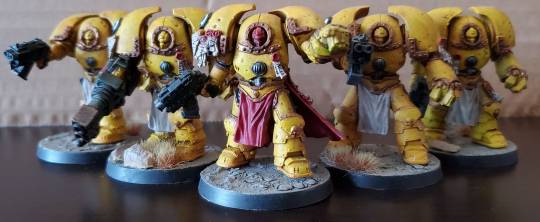

The Saturnine terminators on the top image are Siegemaster Brawlson's personal guard, played as terminators in relic armor. The Chaplain in the second image is one of my favorite minis in the whole army on account of his neat skull!


I don't like mixing primaris and non-primaris marines in any given army. Since they're now statistically roughly the same, I find some way to differentiate counts-as primaris units from regular marines in such armies. In this one, I've decided that any unit in iron-pattern armor is primaris, so the top image is a squad of Sternguard vets with a primaris ancient, captain and lieutenant.
The bottom image is a command squad with a captain (Captain Thundershout) and a lieutenant, enshrining my best-performing miniature in 8th edition, my apothecary, who strangely always managed to be the last man standing in no fewer than five games and managed to kill enemies that outclassed him (Notably including Typhus on one occasion and a Custodian Shield Captain on another.) thoroughly with nothing but, at the time, a bolt pistol.
23 notes
·
View notes
Text
Okay so today I'm feeling lazy enough to not do the great ork photo dump so let's do one of more small,but one of my favorites,my Death Guard kill team: the Scions of Rust





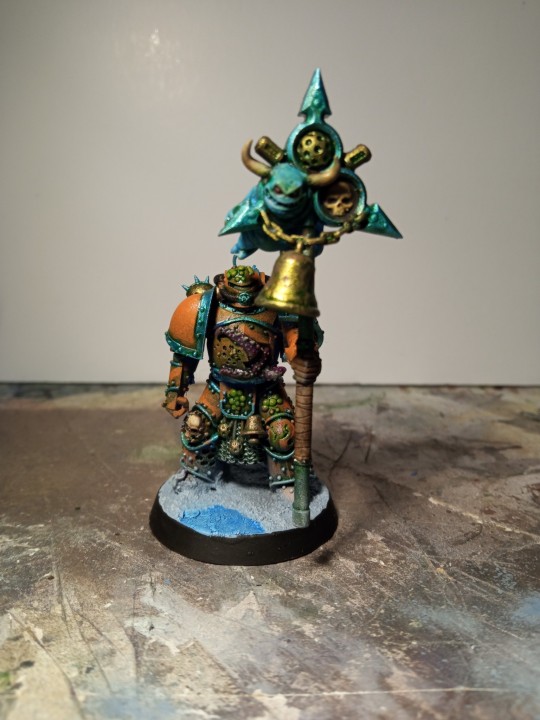


Okay so,a little commentary: half of these come from the 8th starter set "First Strike",which was at the same time my first contact with 40k and a gif from my aunt,so I will always have someone to point to blame for my plastic addiction.
The other half and some bits of the champion are 3d printed by a friend of mine,they are free in 3dcults so if someone asks maybe I edit the link here.
In paintjob per se there's not too much to talk about, the blue-orange contrast makes for a beautiful color scheme and, while the ice bases need some work in these photos, I have already fixed them with some vallejo snow
Someday I will have a kill team for each chaos god but rn I will just congratulate the 40k brothers for finally having tasteful rules for DG
40 notes
·
View notes
Text
I've never felt a closer to grim ironic mirror of Warhammer 40k than looking at the Indomitus crusade storyline in hindsight in a "post pandemic" world.
The focus on returning to normally and restoring the empire only so the Imperium can return to being the #1 source of human suffering.
A Dramatic change in leadership that does ultimately nothing to the status quo.
a "New guard" with lit deadened empathy. Anyone lost to the wages of time and change just "weren't going to make it anyways"
Don't even know where to begin with the constant preaching of returning to a normal that never existed and that "we can't live in fear", with the "fear" being the consequences of their own apathy.
This isn't by any means a praising of the storytelling of 8th-10th edition 40k.
The storyline being wrought onto the "post covid" public is lit as vapid as an action figure commercial
19 notes
·
View notes
Text
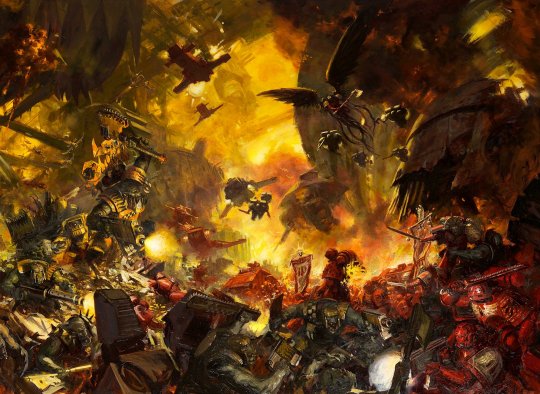
Blood Angels Codex (8th Ed) - Battle for the Shrine World of Belisor by Paul Dainton
#Warhammer#40k#8th Edition#Blood Angels Codex#Blood Angels#Imperium#Imperium of Man#Adeptus Astartes#Space Marines#Belisor#Sci-Fi#Ork#Xenos#Games Workshop#Paul Dainton
39 notes
·
View notes
Text
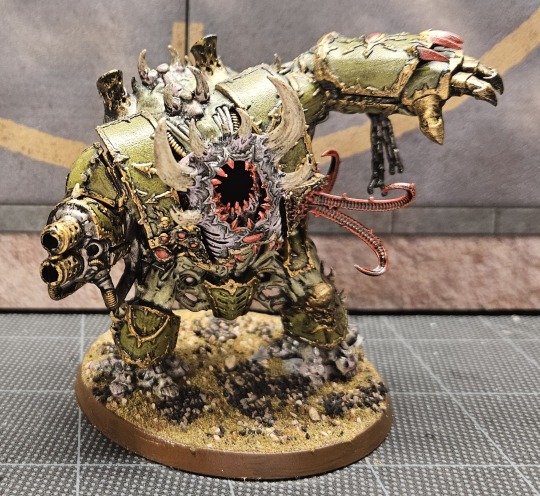

A friend of mine went to the thrift store to buy a suitcase and inside he found two plastic Helbrutes and another dozen plastic Chaos Space Marines, definitely a bargain for $10. He doesn't play chaos space marines, neither do I anymore, but I asked him if I could paint one of the brutes just for fun.
Ages ago... when the Nurgle Marines main combat ability was to be slow and thick I did have a plague Marine army, using all the old mutant gut spilling out pewter and Lead plague marines. And they were terrible. I used them in a few games, threw in some demons, threw in some vehicles, they just were stinkers. When 8th edition of 40K came out my nephew was really excited by the plague Marines in the Box so I gave him all of my old kit to bulk up his forces. The Brute above is painted in the same way that I did all the old plague Marines.
27 notes
·
View notes
Text

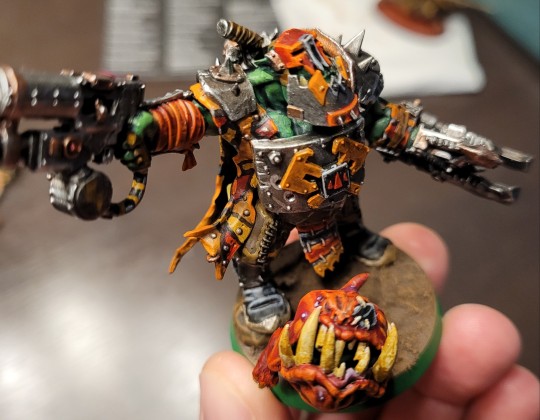
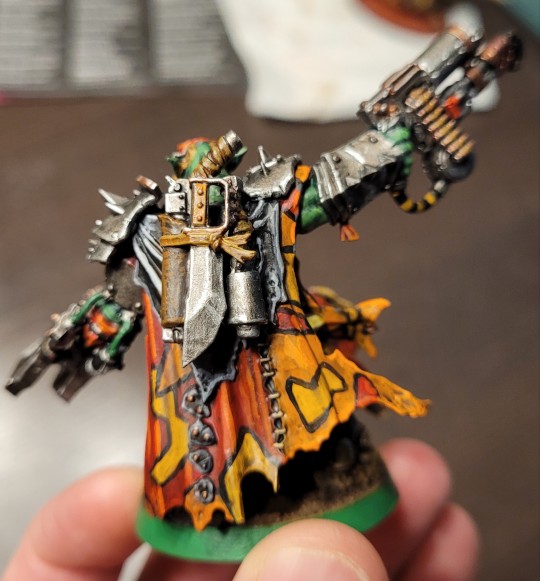
My buddy Dan converted this Ork warboss for me after a hard-fought campaign when our group got back into 40k during 8th edition. After too long, he has been painted and named Gorg Bloodgutz. He's now ready to lead my Orks into tenth edition!
32 notes
·
View notes
Text

So most canon sources don't tell Carnage or Slaughter apart, but the 40k 8th Edition Codex does! Looks like I guess wrong oops lmaooo
Khazaan should be Slaughter and Kha'xanzyr should be Carnage. It's all good tho, I can just flip them around!
7 notes
·
View notes
Text
Looks like /tg/ is cooking up an old style rule set for Warhammer 40k roughly based around 4th edition. Good to see that there are a lot of people who feel the same way I do (Heresy is so enjoyable to me precisely because it’s based on the older style rules without all the post-8th edition reworks and other garbage)
Hopefully this’ll go somewhere, probably the only way to get me to play 40k again
3 notes
·
View notes